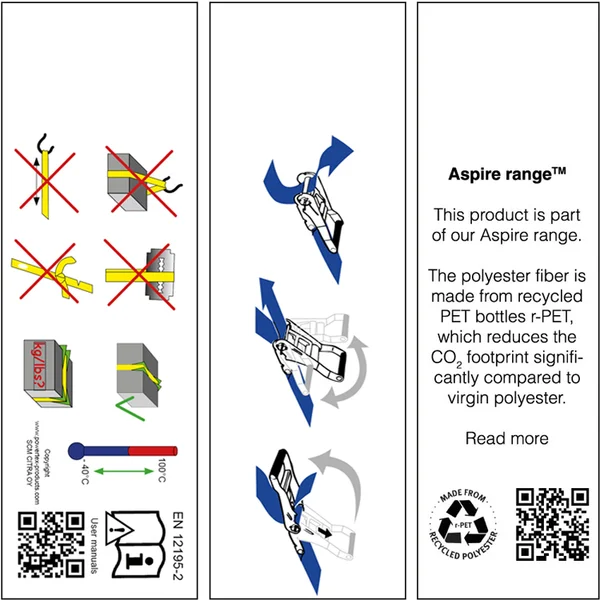Understanding labels

Understanding the Labels on Your Lashings
All of our lashings come equipped with three or four labels, whether they are made from r-PET or other materials. These labels contain valuable information that is crucial for the proper use and maintenance of the lashing. This article provides a detailed explanation of what each label means.
The Blue Label
The blue label on your lashing carries essential information that you need to understand. It is a critical component of the lashing, as the lashing cannot be approved if the label is missing or unreadable. If the label is lost between two service inspections, the lashing should not be used.
In this article, we break down the information on the blue label and explain how you can verify when your product was last inspected and approved.
The part of the label that is sewn between the webbings is hidden from view but remains attached even if the visible part of the label is pulled off. This allows the product to be tracked, though it doesn’t mean the lashing is still safe to use.
Here is what the information on the blue label represents:
- Model Designation: Identifies the specific model of the lashing.
- SHF (Standard Hand Force): The force applied by hand when tensioning.
- STF (Standard Tension Force): Also known as standard tightening or slack force, indicating the tension applied during design testing for frictional lashing.
- Elongation: The stretch of the textile webbing under load.
- Material: The type of textile used in the webbing.
- LGF (Length of Handle): The length in millimeters of the tamp on the handle.
LGL (Length of Loose Webbing): The length in millimeters of the loose webbing. - LC (Lashing Capacity): The maximum load the lashing can safely handle.
- Production Year: The year the lashing was manufactured.
- Batch Number: The manufacturer’s tracking code for the production batch.
- Serial Number: A unique identifier for tracking the specific lashing.
- Warning: Indicates the lashing is not for lifting or pulling.
- Standard: Reference to the European standard EN 12195-2.
- Manufacturer Information: The name or logo of the manufacturer or supplier, along with their website.
- Inspection Calendar: A calendar to mark the next inspection date (12 months from the commissioning date). It is the customer’s responsibility to mark this correctly.
- Aspire Range™ Symbol: Indicates that the lashing is part of the Aspire range™, made from r-PET, which significantly reduces the CO2 footprint compared to traditional polyester.

Understanding these labels ensures you use your lashings safely and in compliance with regulations.
Understanding the White Labels on Your Lashings
Beneath the blue label on your lashing, you’ll find two white labels that provide additional important information.
First White Label
This label includes recommended uses for your lashing, along with the temperature range in which it can be safely used. There is also a QR code that links directly to our online instructions for all POWERTEX products, providing easy access to detailed usage guidelines.
On the reverse side of this label, you’ll find instructions on how to correctly thread the webbing into the ratchet, ensuring you can properly tighten and later release the lashing. For optimal safety and effectiveness, we always recommend using edge or corner protection with your lashings.
Second White Label: Aspire Range™
The second white label indicates that the product is partially made from recycled materials, specifically designed to minimize the CO2 footprint. This label is part of our Aspire range™, which focuses on sustainability. You can learn more about our Aspire range™ through the provided resources.
By understanding the information on these white labels, you can ensure that you’re using your lashings safely, effectively, and in an environmentally responsible way.

Do you wish to know more about our Lifting KnowHow? Please reach out.
For faster response, call us directly at +47 66 79 95 00!
Lashing labelsTechnical description lashing labels. |
Learn more |
Load securingTechnical description lashing products. |
Learn more |


